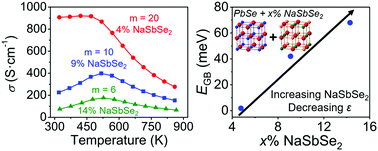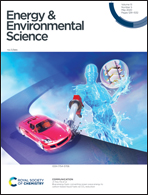Understanding the thermally activated charge transport in NaPbmSbQm+2 (Q = S, Se, Te) thermoelectrics: weak dielectric screening leads to grain boundary dominated charge carrier scattering†
Abstract
Many thermoelectric materials feature irregular electrical conductivity with thermally activated transport below ∼600 K and metallic behavior at high temperatures, despite possessing degenerate carrier concentrations. The suppression of the electrical conductivity ultimately degrades the thermoelectric performance on the cold side and limits the device energy conversion efficiency. As such, establishing the origin of the low temperature scattering and developing strategies to mitigate its effect are paramount issues. To date, the correct microscopic description of the low temperature carrier scattering remains an open issue, and there is little work addressing why some thermoelectric materials are more susceptible to the deleterious behavior. Here, we use the promising thermoelectric alloys of PbQ and NaSbQ2 (Q = S, Se, Te) as model systems to address these concerns. We directly show the thermally activated transport stems from the scattering of charge carriers by the grain boundaries (GBs), and that the expected metallic electrical conductivity is recovered by preparing large grained samples with reduced densities of GBs. We furthermore study the electrical properties NaPbmSbSem+2 as a function of NaSbSe2 fraction, as well as those of the chalcogenide analogues, PbTe–NaSbTe2 and PbS–NaSbS2, and demonstrate that the strength of GB scattering can be understood by utilizing simple chemical principles. By considering the polarizability of the host atoms, we directly relate the magnitude of GB scattering to the relative degree of charge carrier screening in each material, and demonstrate that GB scattering is strongest in the ionic NaSbQ2-rich compounds and weakest in more polarizable PbQ-rich phases. We finally show how these chemical arguments elegantly explain the strong GB scattering in numerous other thermoelectric materials. By uniting the deleterious charge transport properties exhibited by many different compounds into a common picture, we discuss how our work gives design principles for proper microstructure engineering in emerging thermoelectric materials.



 Please wait while we load your content...
Please wait while we load your content...